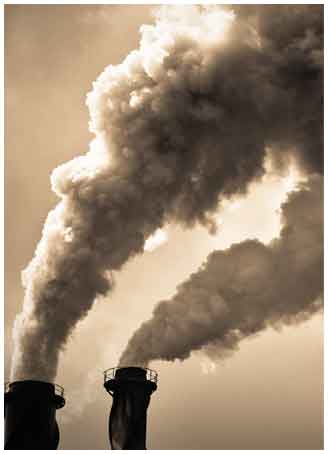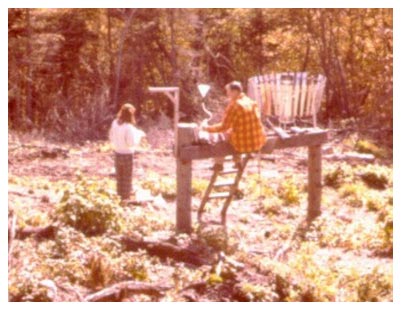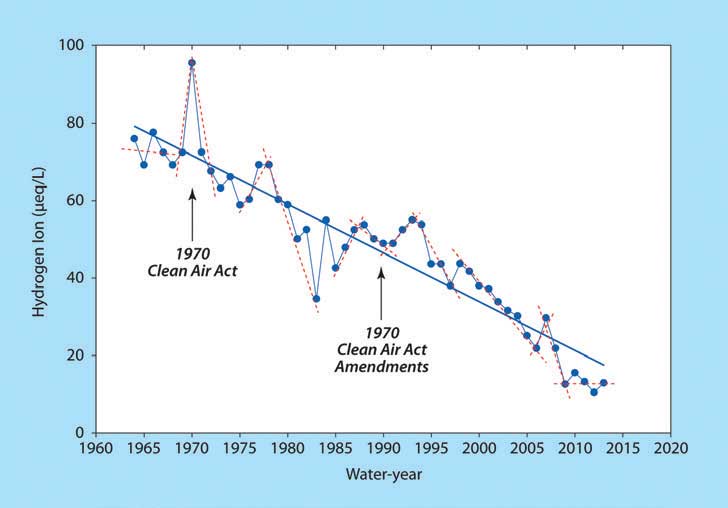
On the morning of June 13, 1974, readers of The New York Times swirled their coffee and mulled the front-page headline, “Acid in Rain Found Up Sharply in East.” A study in the journal Science was reporting that rainfall on the Eastern seaboard and in Europe had become 100 to 1,000 times more acidic than normal—even “in occasional extreme cases,” said the Times, “as acidic as pure lemon juice.” The analogy was a little misleading: Lemon juice is not nearly as corrosive as the nitric and sulfuric acids then raining down on the countryside. But it was enough to make acid rain a topic of anxious national debate.
Both the recognition of the problem and the eventual solution to it would be products of basic research in physical science and in social science—with neither originally directed at any narrow practical purpose. The journey from problem to solution would be tangled and difficult, across unmapped scientific and political territory, over the course of decades. Along the way, scientists would discover that smokestack emissions that were causing acid rain were not only threatening the environment but also the health of tens of millions of Americans. The solution, when it came, would demonstrate the potential of research to be literally a lifesaver.
The authors of the Science study hadn’t set out to find acid rain. Their long-term project was aimed instead at understanding how forest ecosystems work, down to the chemical inputs and outputs. But the first rain sample they collected in the summer of 1963 at the Hubbard Brook Experimental Forest in New Hampshire was surprisingly acidic. By the early 1970s, after almost a decade of corroborating research, they felt confident that acid deposition had become a significant regional problem and a factor in declining forest productivity, fish kills, and the deterioration of buildings and bridges.
Roughly 70 percent of the problematic emissions came from power plant smokestacks, and the Times noted that “no widely accepted, reliable technology” was available to fix the problem. Critics were soon dismissing acid rain as an environmental hoax, with one federal official asserting that any fix would cost $6,000 for every pound of fish saved. But scientific evidence of damage and public concern about acid rain continued to mount. And in 1984, the federal Office of Technology Assessment concluded that acid rain and the associated small particle smokestack emissions “have harmed lakes and streams, lowered crop yields, damaged man-made materials, decreased visibility, and might even threaten human health.”



By 1988, wet scrubbers using limestone to remove sulfur oxides from smokestacks seemed like the best remedy. But research put the likely capital cost at $400 million per power plant, totaling $20 billion for just the nation’s top 50 polluters. One approach at that point could have been for the government to issue regulations and order polluters to install the equipment needed to reduce emissions. But resistance had been building to that “command-and-control” style of addressing environmental issues. Expensive and time-consuming lawsuits were common in such cases. An impasse seemed likely until a way around the problem emerged from a line of pure economic theory that academics had been pursuing over the course of a century.
The first step in that thinking was to recognize the importance of what we now call externalities. That is, transactions between two parties often cause benefits and harms to third parties, or to society, that should be part of the accounting but generally aren’t. The utilitarian philosopher Henry Sidgwick first articulated this idea in his 1883 book The Principles of Political Economy. He did not, however, suggest how to get anyone to pay for externalities.
British economist Arthur Cecil Pigou fleshed out the externality idea in his 1920 book The Economics of Welfare. For broad negative effects on society, he proposed a government tax proportionate to the damage. Such “Pigovian” taxes would in time become a useful tool in certain special cases. The United States, for instance, imposed an excise tax in 1980 on hazardous chemicals to support its Superfund cleanup work and another on petroleum products after the 1989 Exxon Valdez disaster for the Oil Spill Liability Trust Fund. Politicians, pundits, and economists from Al Gore to Alan Greenspan continue today to advocate such a tax on carbon as a means of addressing climate change.
But in 1960 Pigou elicited a scathing attack for his “faulty view of the facts” and “mistaken” economic analysis. In his paper “The Problem of Social Cost,” economist Ronald Coase, then at the University of Virginia, described government-imposed solutions as crude and inefficient. Nor was he impressed by legal remedies, often based on points of law that seemed, to him as an economist, “about as relevant as the colour of the judge’s eyes.” Instead, Coase advocated measures that would make it easier for the affected parties to negotiate and allocate costs in the marketplace. He later admitted that he didn’t recognize the broader implications of what he had written until a colleague pointed them out afterward.

Coase’s paper was enough to influence the Canadian economist John H. Dales. He began his slender 1968 book Pollution, Property & Prices with the engaging promise that it would contain “virtually no factual information and very little in the way of outraged denunciation of evil.” Instead, he declared, “Let us try to set up a ‘market’ in ‘pollution rights.’” Using the example of water pollution in Lake Ontario, Dales proposed that a regional board set an overall limit, or “cap,” on pollution and divide up that cap in the form of annual pollution allowances distributed to major polluters. Some companies might buy additional allowances on the marketplace and increase their pollution. But others would instead choose to improve their wastewater treatment, paying for it in part by selling the allowances they would no longer need. The board might later choose to lower (or raise) the cap, leaving the price of pollution allowances to adjust in the marketplace. It was the system now known as cap and trade. But it was still a long way from being a practical reality.
Among the scholars beginning to consider this idea in the early 1970s was an environmental economist named Dan Dudek. He had learned during a stint working on pollution issues at the U.S. Department of Agriculture that “command-and-control—telling people what to do—is not exactly the way to win friends when dealing with farmers. That part of it got burned off me pretty quickly,” he recalls. Behaviorally oriented approaches to pollution problems began to look like a better alternative. Teaching at the University of Massachusetts in the early 1980s, Dudek turned to Dales both for his understanding of human nature and because he thought the directness and clarity of his writing might appeal to undergraduate students. Later, when he went to work for the Environmental Defense Fund (EDF), Dudek took Dales’ marketplace approach with him, out of the realm of scholarship and into politics.

Incoming President George H. W. Bush promised in 1988 to be “the environmental president.” When EDF suggested that fixing acid rain with a marketplace approach would fulfill that commitment, Bush’s chief counsel Boyden Gray latched onto the idea, which also fit Republican sensibilities. Utility executives loudly objected. So did many traditional environmentalists who saw emissions trading as a way for polluters to buy their way out of fixing the problem. But the marketplace in acid rain emissions became law in the Clean Air Act Amendments of 1990, written in part by Dudek. It set an ambitious goal of cutting those emissions in half, by 10 million tons.

Would it work? No one knew for sure until the program took effect in 1995. Soon after, a federal policy maker browsing through emissions reports stopped dead at one on an Ohio power plant that had been a major polluter. Almost overnight, it had cut emissions 95 percent, from 380,000 tons of sulfur dioxide annually down to 19,000. Other utilities soon joined in and the program hit its 10-million-ton target in 2006. Allowing utilities the freedom to find the most cost-effective way forward for individual power plants—and profit from emissions allowances they no longer needed—proved to be a key factor in the success of the program. According to the most conservative estimate, costs came in at least 15 percent below the cost of the command-and-control alternative. The acid rain cleanup eventually cost less than $2 billion per year, one-third of the federal government’s 1990 estimate.


Today rainfall in the Eastern seaboard is less acidic and visibility has improved dramatically. Gene E. Likens, an ecologist who was among the first to spot the acid rain problem in 1963 (and still continues his research at the Hubbard Brook Experimental Forest), cautions that soils and forests will take much longer to recover. Human health has turned out to be an unexpected beneficiary because of the later recognition that fine particles associated with acid rain emissions were finding their way into peoples’ lungs, causing increased sickness and death from conditions like asthma and bronchitis. The acid rain program now produces benefits estimated at up to $116 billion per year, mostly in avoided mortality.
Building on the American success with cap and trade, in 2005 the European Union (EU) launched a trading scheme to reduce carbon emissions. That program has at times stumbled badly, in part because it issued too many allowances at first, but also because reducing carbon emissions has turned out to be a much larger and more difficult proposition. Even so, the EU program appears to have stabilized and gained acceptance in the business community. It now covers 11,500 power plants, factories, and other facilities in 31 countries.
In 2009, Congress declined to establish such a cap-and-trade program for carbon emissions in the United States. But that same year, a group of Eastern states representing one-fifth of the nation’s gross domestic product launched a regional cap-and-trade program. California and three Canadian provinces are now banding together on a similar program. And in September 2015, China’s president came to Washington, DC, to announce plans to implement cap and trade on carbon emissions nationwide in 2017. It will be the largest cap-and-trade program in the world.
None of this would have happened without the initial intellectual spark struck by the theories of social scientists Pigou, Coase, and Dales. “It’s hard to imagine that coming from government officials, bogged down” in the day-to-day details of managing programs, said Dudek, who is now advising China. For big transformative ideas like a marketplace in pollution, it takes basic research broadly defined and insulated from short-term considerations. For Dudek, there is consolation in knowing that China at least will still benefit from such basic research, even as the United States is, at least for the moment, holding back.
This article was written by Richard Conniff for From Research to Reward, a series produced by the National Academy of Sciences. This and other articles in the series can be found at www.nasonline.org/r2r. The Academy, located in Washington, DC, is a society of distinguished scholars dedicated to the use of science and technology for the public welfare. For more than 150 years, it has provided independent, objective scientific advice to the nation.
Please direct comments or questions about this series to Cortney Sloan at csloan@nas.edu.
Photo and Illustration Credits:
Smokestacks: iStock • Tree injury*: G.J. Hawley • Shenandoah stream: Ami Riscassi • Ronald Coase: Coase-Sandor Institute for Law and Economics, University of Chicago Law School • George H. W. Bush: White House Photo/Alamy Stock Photo • Barack Obama and Xi Jinping: Mark Wilson/Getty Images • Collecting rain sample*: Gene E. Likens • Precipitation acidity graph*: Gene E. Likens • Items marked with an asterisk published in Holmes, R. T., and G. E. Likens. 2016. Hubbard Brook: The Story of a Forest Ecosystem. New Haven, CT: Yale University Press.
© by the National Academy of Sciences. These materials may be reposted and reproduced solely for non-commercial educational use without the written permission of the National Academy of Sciences.
Copyright ©
National Academy of Sciences. All rights reserved.
Terms of Use and Privacy Statement

